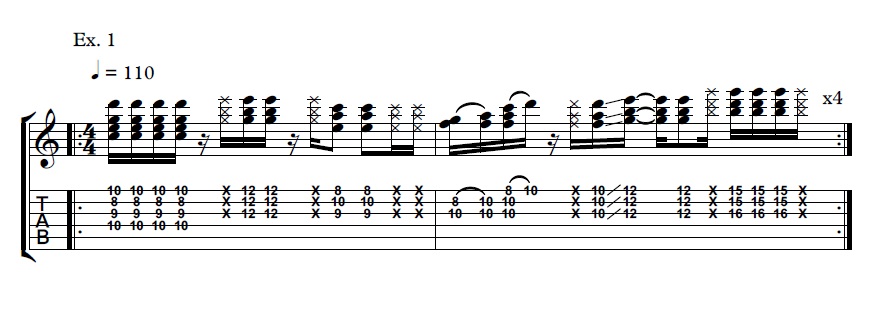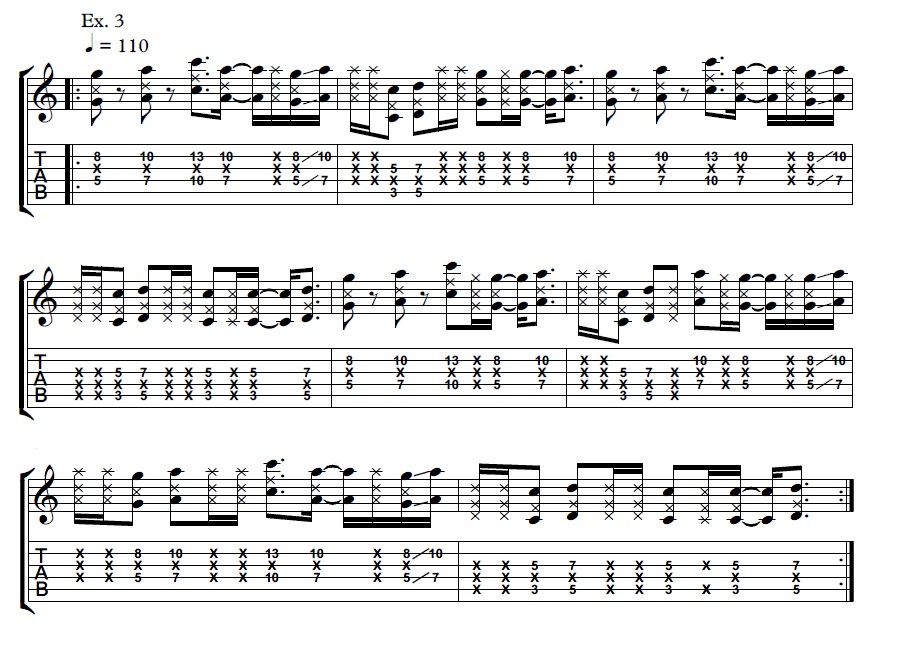Funk Rhythm Guitar Pop Style
By Rob Thorpe
Here we’ll be exploring a couple of ideas central to creating authentic parts in pop and funk rhythm guitar settings. As a working musician these are the tools that you use all the time, so it’s worth investing the time to nail them down.
The elements we’re dealing with here are high chord inversions, octaves, palm muting, dead notes and single string lines.
With all of these examples the underlying feel is 1/16th notes (four notes per beat) so although all the notes in the bar might not be played it will really help your funk rhythm guitar accuracy to ‘ghost’ all of the notes by keeping the picking hand rocking in time just above the strings and then bringing it onto the strings for the required notes.
Getting the right tone is will make all the difference. A bridge single coil is best, or position 4 on a Stratocaster’s five-way switch. You’re aiming for a really crisp bright sound that will cut through the mix and accentuate the percussive subtleties in your playing. With single coil pickups, the stronger the attack the brighter and more biting the sound, so don’t be afraid to dig in hard with the pick!
Funk Rhythm Guitar Example 1

Being able to play chords higher on the fretboard instead of relying on stock barre and open string shapes is a must for this style. I’ve taken a basic pop progression in Cmajor (C, Am, F & G) and tried to pack the two bars with various shapes and appropriate embellishments to give you a starting point to make your own.
Funk Rhythm Guitar Example 2

David Williams, Michael Jackson’s long-time collaborator was brilliant at creating hooky single note lines that made the funk rhythm guitar parts as memorable as the vocal melody! Careful use of palm muting and heavy picking to give plenty of dynamic variation between choked dead notes and snappy accents. Great examples of his playing are Wanna Be Startin’ Somethin’ and Don’t Stop Till You Get Enough.
Funk Rhythm Guitar Example 3
Octave riffs are huge part of funk maestro Nile Rodgers’ playing style. This is a very percussive style so don’t be gentle about strumming hard. It’s down to your fretting hand to make sure all the other strings remain muted. I’d use first and fourth fingers for all octave shapes and make sure to keep the fingers flattened again the strings so as to keep everything else nicely muted.
Apply these ideas in context to really explore them properly, and come up with variations and embellishments once you’re comfortable with them. Try jamming along to pop tunes such as Michael Jackson, Bruno Mars or anything Motown based. I Want You Back by The Jackson 5 is a classic tune and incorporates octaves, chord inversions in the chorus and double stop fills in the verse and bridge.
Finally, consistency is key to funk rhythm guitar playing. Though these ideas are simple you want to be able to lay them down with the kind of polish and rhythmic accuracy you would want when recording, every time. That’s no mean feat, but you want the band to be able to rely on you 100%. The best way to practice this is to record yourself. Play along to a drum loop and trying to lock into the sixteenth note subdivisions. If you can overdub multiple takes so they sit together perfectly then you’re in the realm of the pros!
“The artists you work with, and the quality of your work speaks for itself.”
Tommy Emmanuel
© Copyright Fundamental Changes Ltd 2025
No.6 The Pound, Ampney Crucis, England, GL7 5SA

